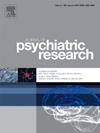Blunted niacin skin flushing response in violent offenders with schizophrenia: A potential auxiliary diagnostic biomarker
IF 3.7
2区 医学
Q1 PSYCHIATRY
引用次数: 0
Abstract
Schizophrenia (SZ) is associated with an increased risk of violence, with clinical diagnosis primarily relies on symptomatology. The niacin skin flushing response (NSFR) is proposed as a potential biomarker for SZ, but its effectiveness in violent offenders with schizophrenia (VOSZ) remains unevaluated. This study investigates whether the diagnostic model differentiating general SZ patients (GSZ) from healthy controls (HCs) using NSFR can also distinguish VOSZ from HCs. SZ patients were continuously sampled based on the International Classification of Diseases, 10th Edition, and categorized into VOSZ (with a history of violent crimes), and GSZ (without such history). HCs had no psychiatric illnesses or violent crime history. A total of 315 VOSZ, 296 GSZ, and 281 HCs were recruited. Least absolute shrinkage and selection operator regression was used to select variables and construct diagnostic models based on NSFR. No significant differences in age, sex or BMI were observed among groups. Both VOSZ and GSZ exhibited similar blunted NSFR compared to HCs. The diagnostic model constructed by 14 NSFR variables distinguishing GSZ from HCs was successfully transferred to distinguish VOSZ from HCs, with areas under the curve of 0.796 (specificity = 81.6%, sensitivity = 64.2%) and 0.798 (specificity = 80.0%, sensitivity = 70.2%), respectively. Moreover, NSFR was unrelated to illness severity, violence, or antipsychotic dosage in VOSZ, suggesting it is a trait indicator of SZ. This study supports the NSFR as an objective diagnostic biomarker for distinguishing VOSZ from HCs, expanding its applicability, although it may not specifically identify violent offenders among SZ patients.
求助全文
约1分钟内获得全文
求助全文
来源期刊

Journal of psychiatric research
医学-精神病学
CiteScore
7.30
自引率
2.10%
发文量
622
审稿时长
130 days
期刊介绍:
Founded in 1961 to report on the latest work in psychiatry and cognate disciplines, the Journal of Psychiatric Research is dedicated to innovative and timely studies of four important areas of research:
(1) clinical studies of all disciplines relating to psychiatric illness, as well as normal human behaviour, including biochemical, physiological, genetic, environmental, social, psychological and epidemiological factors;
(2) basic studies pertaining to psychiatry in such fields as neuropsychopharmacology, neuroendocrinology, electrophysiology, genetics, experimental psychology and epidemiology;
(3) the growing application of clinical laboratory techniques in psychiatry, including imagery and spectroscopy of the brain, molecular biology and computer sciences;
 求助内容:
求助内容: 应助结果提醒方式:
应助结果提醒方式:


